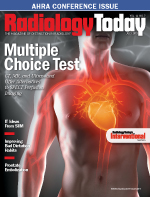 July 2013
July 2013
Scientific Artists
By Jim Knaub
Radiology Today
Vol. 14 No. 7 P. 3
Grounded In the measurable, reproducible world of science, physicians expect to be shown the data that one procedure or treatment is effective, or works better than another. But many physicians also want the wiggle room to weigh their personal experience and knowledge more heavily than some other scientific data in making a medical decision. They decry the cookbook medicine of making decisions based solely on guidelines.
For example, when an ophthalmologist says the phrase “in my hands,” it tends to mean that his or her explanation for varying from accepted standard surgical technique is forthcoming. (That lesson came from my initial foray into health care reporting years ago with a magazine called Ocular Surgery News.) In my hands also incorporates the tacit admission that medicine and surgery are very much in nearly equal measure art and science.
In my eyes, medicine is an art performed by men and women of science. Physicians are trained in the sciences and the scientific method, but their application of that knowledge is artful. Watching physicians balance data and personal experience, quantifiable and subjective assessment, or any other aspects of the art vs. science issue fascinates me. Some doctors more comfortably navigate terrain of a discipline that is both art and science.
This topic of art vs. science found its way into this issue’s cover story on cardiac perfusion imaging. SPECT perfusion imaging has a long, proven clinical track record in helping physicians assess blood flow through the heart and cardiac damage. While trusted, SPECT does not fulfill the scientist’s desire for a quantifiable exam.
“SPECT is the visual assessment of uptake of radiotracer into the myocardium. It makes the reader’s interpretation subjective—whether it’s positive or negative,” Ricardo C. Cury, MD, told writer Beth W. Orenstein. MRI, CT, and PET perfusion studies may offer the quantification that many desire. Orenstein reports on different myocardium perfusion exams and how some physicians and facilities are using them to evaluate heart disease. The article is not some greatly exaggerated report of SPECT’s demise; its reliability, availability, and utility are too well established. But other tools are being used and evaluated in search of a better perfusion mousetrap.
And later this month stop by booth 123 at AHRA 2013 in Minneapolis.
Enjoy the issue.
jknaub@gvpub.com

